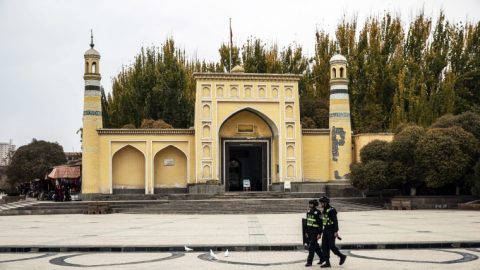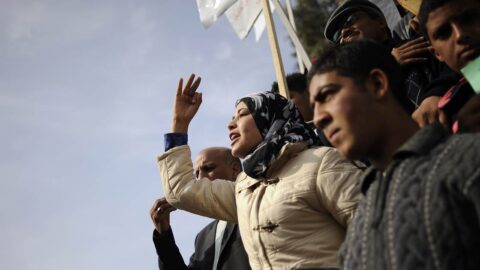KABUL, Afghanistan — The music that emanated from Meena Karimi’s cello evoked the cries of Afghan women.
The 16-year-old, a student at the Afghanistan National Institute of Music in Kabul, hopes to one day compose a final movement for her piece, which reflects the struggle of her female compatriots. But a happy ending for Afghan women feels more remote by the day, and Karimi’s piece remains unfinished.
Along with that of millions of women and girls in Afghanistan, Meena’s future hangs in the balance after the United States began the process of withdrawing from the country and as the Taliban insurgents weigh their next move.
U.S. forces have had boots on the ground since October 2001, when they led an invasion of Afghanistan and toppled the hardline Islamic Taliban regime for harboring Osama bin Laden, the architect of the Sept. 11, 2001, terror attacks.
The invasion triggered a huge change for many mostly-urban women and girls, sweeping out the Taliban’s strict version of Islam that restricted women’s rights and ushering in a constitution that enshrined equal rights for men and women.
Women went from being practically invisible in public life to re-entering schools and universities, becoming members of Parliament and returning to the office.
Nearly 20 years later, educated women are now bracing themselves to defend the gains they have made, including the right to perform music — something the austere Taliban banned.
The militants currently control or contest more than half the country, and many women fear that they will attempt to reinstate their draconian rule if they return to power nationally.
Today, as many as 3.5 million out of the roughly 9 million students enrolled in school are girls, according to a report in February by the Special Inspector General for Afghanistan Reconstruction, a U.S. government watchdog. And a recent survey of Afghans found that more than 8 out of 10 respondents said it was very important to protect women’s rights in a peace deal.
Under the militants’ regime, girls were barred from attending school and women were not allowed to work outside the home or to appear in public without an all-encompassing body covering and a male escort. Violators of these rules or edicts were flogged in public, or executed.
Despite the militant group’s dismal record on the rights of women and girls, Taliban spokesman Zabihullah Mujahid said it would write laws to ensure the participation of women in public life.
“The purpose would be enabling women to contribute to the country in a peaceful and protected environment,” he said, alluding to the Taliban’s talking point that the country is not being ruled according to the Sharia — in spite of the fact that the current constitution was written in accordance with Islamic law.
Download the NBC News app for breaking news and politics
Women’s access to education and health care, while improved, are still limited in Afghanistan.
In 2017, 39 percent of girls were literate compared to 20 percent in 2005, according to the special inspector general.
There is good news for women on some fronts. For example, maternal deaths per 100,000 births dropped from 1,300 in 2002 to 638 in 2017, according to data compiled by the World Health Organization, among other groups.
But the lives of women living under the Taliban’s rule are more restricted than those in other parts of the country. Education for most stops at puberty, and women are not allowed to go to the bazaar, or market, alone, according to 2018 research by Ashley Jackson of the Overseas Development Institute, a London think tank.
Jackson told NBC News she thought the Taliban were likely to oppose women working outside the home, except in areas such as education and health care, which are gender segregated.
Department of State spokesman Ned Price said at a media briefing last week that the U.S. had “made clear that any country that seeks international legitimacy, that wishes not to be a pariah, needs to respect women and girls, and that includes any future government in Afghanistan.”
When Meena was asked whether she worried the militants could put a halt to the progress that has enabled her to study music, now that the U.S. is leaving, she replied, “I do worry about it.”
She is not the only one.
“I’m really conscious about it,” said Sana Zazai, a 10th grade student at the Adei School across town, who says she’d like to be a psychologist in the future. “School really matters to us.”
Najla Safai, another student at the school, said she hopes one day to be a gynecologist but acknowledges that this dream may be thwarted if further violence breaks out.
“When you don’t have a peaceful life, how would you study?” she said.
Even without more violence and Taliban-era restrictions on their rights, Afghanistan remains one of the most difficult places in the world for women and girls.
From 2002 to 2020, the U.S. disbursed more than $787 million for programs that “specifically and primarily” supported Afghan women and girls, according to the special inspector general. And yet, Afghan women continue to face high mortality and poverty rates, discrimination and violence.
Meena remains defiant.
“No matter what, I will play music and will help other girls to play music,” she said.
Richard Engel reported from Kabul, and Saphora Smith reported from London.
Marc Smith, Gabe Joselow and Mushtaq Yusufzai contributed.










Recent Comments